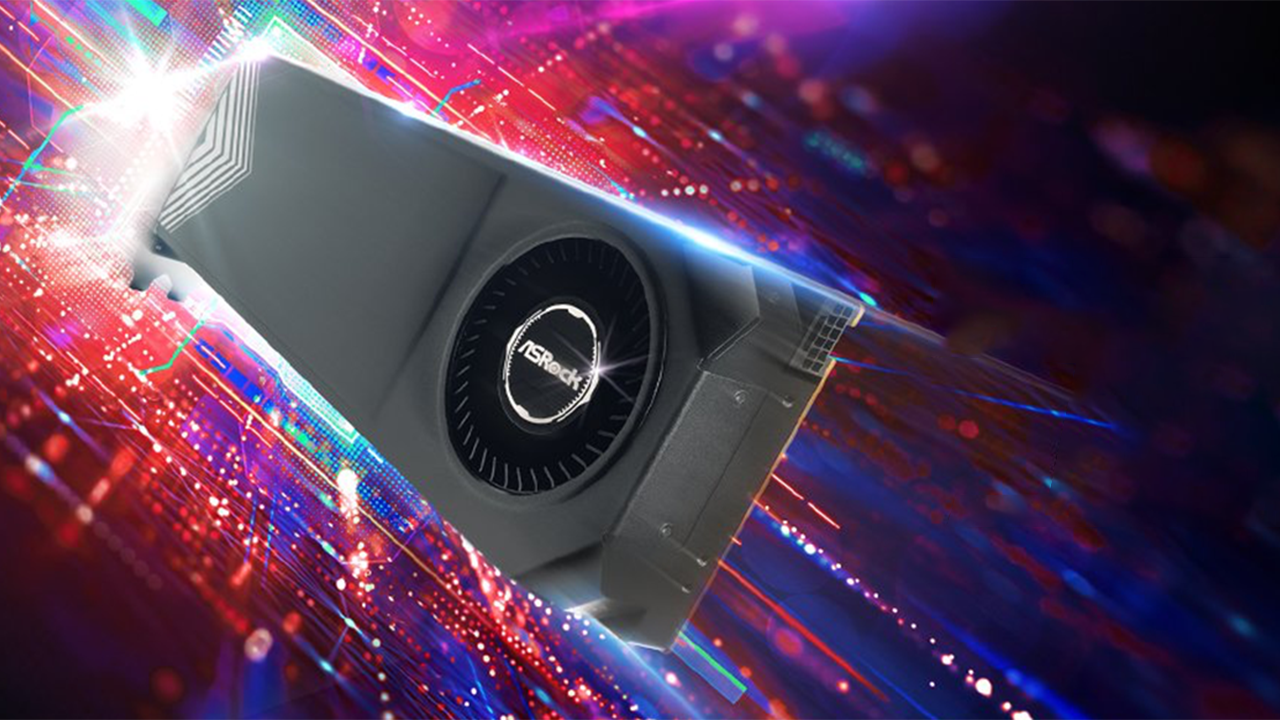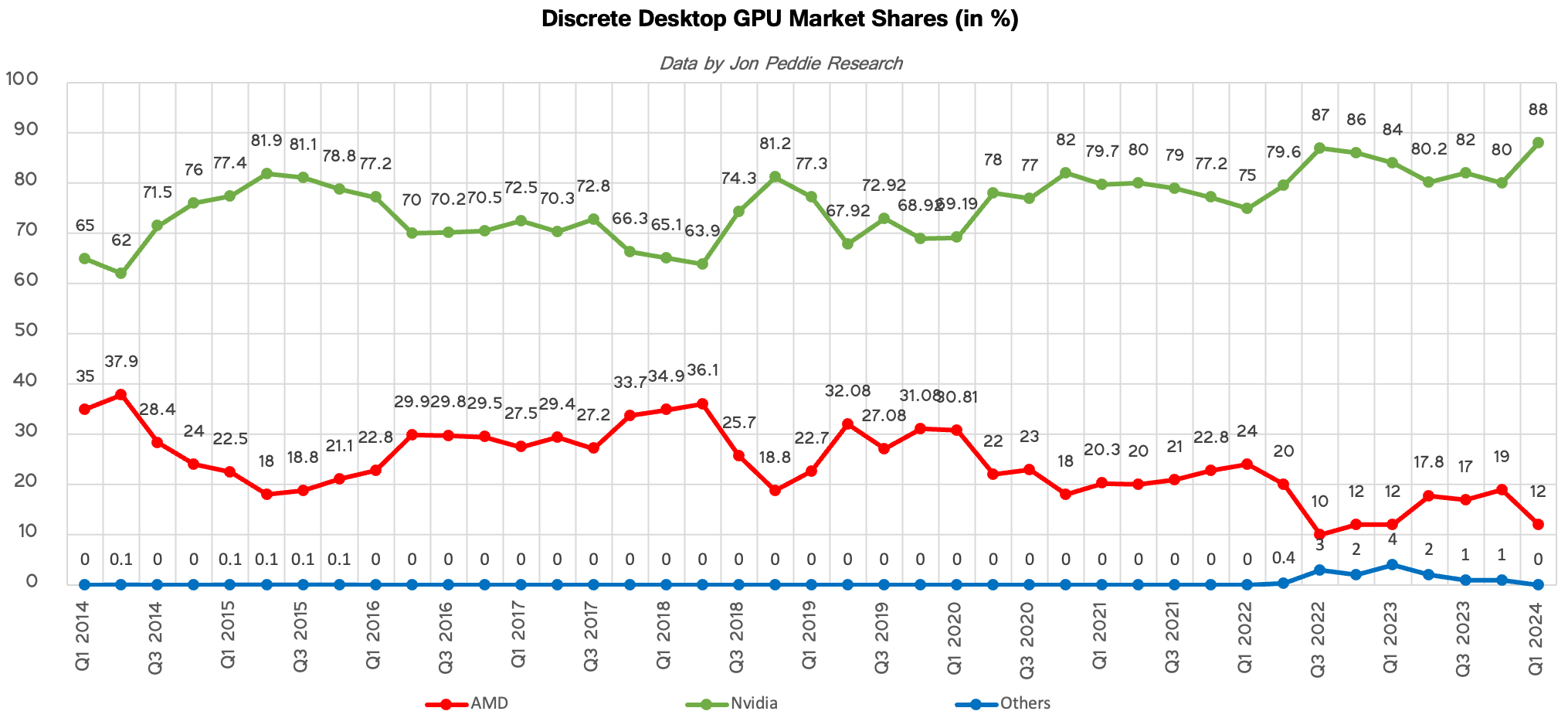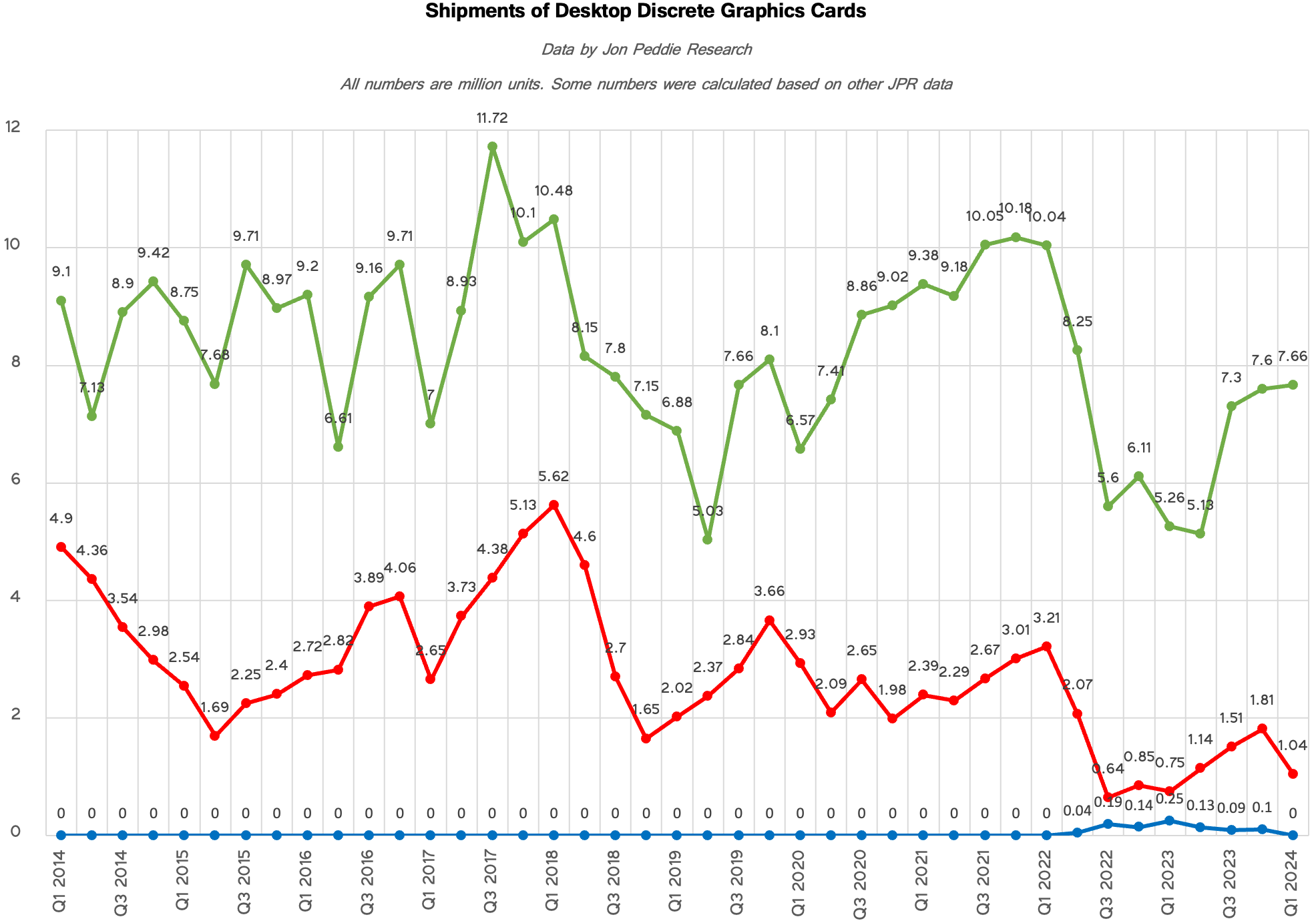Nvidia's grasp of desktop GPU market balloons to 88% — AMD has just 12%, Intel negligible, says JPR
The discrete GPU industry is returning to seasonality.

Sales of desktop discrete graphics cards declined quarter-over-quarter, but improved year-over-year in Q1 2024, a recent report from Jon Peddie Research (JPR) shows. However, the performance of the two leading suppliers of standalone graphics processors was completely different: despite the market decline, Nvidia increased its sales and gained share (to 88%), whereas AMD's shipments decreased and the share fell sharply (to 12%). Both vendors are well-represented in the ranks of the best graphics cards available today.
The industry shipped 8.7 million desktop add-in-boards in the first quarter, a decline from 9.5 million units in the previous quarter. Despite this quarterly drop, the market experienced a robust 39.2% increase in shipments compared to the same period last year, according to JPR's report.



Nvidia solidified its dominance with an 88% market share, growing by a whopping 8% from the previous quarter. Shipments of Nvidia's GPUs for desktops totaled 7.66 million units, up from 7.6 million in Q4 2023 and around 5.26 million in Q1 2023.
By contrast, AMD saw a 7% decrease in market share quarter-over-quarter but a modest increase in its yearly market share as the company's shipments fell by 41% from the previous quarter, but rose by 39% compared to the previous year. The company shipped around 1.04 million desktop discrete GPUs in Q1 2024, down from 1.81 million in the previous quarter and up from 0.75 million in the same quarter a year ago.
Intel, which entered the AIB market in Q3 2022 with its Arc A770 and A750 models continues to struggle for a foothold against established competitors like Nvidia and AMD. The company's shipments in Q1 2024 were negligible, based on data from Jon Peddie Research.
"We and the industry have been hoping for a return to seasonality, which was the hallmark of the PC industry for so many decades," said Dr. Jon Peddie, president of Jon Peddie Research. The research firm head went on to explain that the GPU market was strongly disrupted by the recession in 2007-2008, and never fully recovered before the ensuing cryto-craze, COVID pandemic, and the onset of the Russia-Ukraine war.
"In 2023, we saw four quarters of welcomed growth, and when Q1 2024 was down a bit, no one panicked, as it looked like a return to seasonality — Q1 always used to be flat to down," commented Peddie. "Therefore, one would expect Q2 2024, a traditional quarter, to also be down. But, all the vendors are predicting a growth quarter, mostly driven by AI training systems in hyperscalers. Whereas AI trainers use a GPU, the demand for them can steal parts from the gaming segment. So, for Q2, we expect to see a flat to low gaming AIB result and another increase in AI trainer GPU shipments. The new normality is no normality."
Get Tom's Hardware's best news and in-depth reviews, straight to your inbox.

Anton Shilov is a contributing writer at Tom’s Hardware. Over the past couple of decades, he has covered everything from CPUs and GPUs to supercomputers and from modern process technologies and latest fab tools to high-tech industry trends.
-
benjaminbrowne06 The sad part is that AMD cards are more efficient and run cooler, but until they fix their buggy software drivers no one will care.Reply -
gamerk316 Reply
Case in point: I once purchased an ATI 4890 as an upgrade for my aging 7800 GTX. The software never installed right as the GUI kept crashing; I had to install via command line. Oh, and the card outright died after 5 months of moderate use.benjaminbrowne06 said:The sad part is that AMD cards are more efficient and run cooler, but until they fix their buggy software drivers no one will care.
So yeah, that experience going away from NVIDIA as well as the continued reports of software problems (let alone no access to DLSS and the like) are reasons why I don't even consider an AMD GPU. Heck, it took until just last year for me to even consider one of their CPUs (due to Intel clearly being behind nowadays). -
NeoMorpheus Those free 3090s and 4090s given to all influencers have provided some sweet results.Reply -
JarredWaltonGPU Reply
Only a few AMD architectures have been more efficient than Nvidia's competing architectures in recent history, and temperatures are more about firmware and fan speed curves than anything. Basically, you should only look at performance and power use with temperature being a factor of the specific card(s) you're looking at rather than the architecture as a whole.benjaminbrowne06 said:The sad part is that AMD cards are more efficient and run cooler, but until they fix their buggy software drivers no one will care.
The RX 6000-series tended to use slightly less power than the RTX 30-series, but even RDNA 2 vs. Ampere wasn't always a win. Navi 33 GPUs for example tended to use more power proportionally compared with the higher tier Navi 32 and Navi 31 cards.
But at present? Ada currently blows AMD efficiency away, in terms of FPS/W. RTX 40-series GPUs are roughly 50% higher performance per watt than RDNA 3. GPU chiplets certainly didn't help AMD's efficiency use case, probably contributing at least 10-20 watts to power draw is my guess. It would have been interesting to see what RDNA 3 as a monolithic chip on TSMC N5 could have done, but that was not the goal. -
I find the latest Nvidia ADA GPUs to run more efficient and cooler than my previous AMD cards, like the RX 480 GPU. Currently rocking the RTX 4060.Reply
And that's a fact since the "Ada Lovelace" arch is FAR more efficient than AMD's RDNA 3.
Regarding driver support ?
To be honest, AMD used to have issues with its GPU drivers, particularly at launch, which hampered the performance. However, AMD’s software has improved significantly in the last few years, bolstered by frequent driver updates, resulting in much improved performance overall.
While both AMD and Nvidia update their drivers on a regular basis, due to higher demand for Nvidia’s GPUs, not to mention Nvidia’s deeper pockets, developers tend to favor Nvidia, offering much better support for those with an Nvidia graphics card.
That doesn't mean AMD cards and their driver support is bad. Nope. At least in my opinion, AMD has improved their GPU drivers. I never had any issue with my RX 480 card. But maybe that's just me.
I don't favor any camp though. I'm just stating the facts based on my own personal observation. Even INTEL is in a much better position now. Arc GPUs first arrived in 2022 and had plenty of early growing pains.
The latest drivers have come a long way, and the upcoming Battlemage "Xe2" GPU should also benefit from everything that came before, with improvements in the core architecture to remove bottleneck and limitations present in the first generation of Xe Graphics.
It's impressive to witness how much effort Intel's driver team has done in the past one year or so. Current Alchemist A-series ARC discrete GPUs have seen a pretty decent performance uplift in most of the latest AAA/AA games, if not all.
We just need more mainstream GPUs in a price bracket that a lot of gamers can afford, and not some highly expensive or a HALO product (thinks of RTX 5090) . -
pug_s I brought some Radeon 6000 series graphics cards about 1.5 years ago when the price of these things are affordable. Let's face it, AMD and Nvidia are making hand over fist selling AI accelerators and has little incentive to make improvements of their graphics card lineup.Reply -
ReplyJarredWaltonGPU said:But at present? Ada currently blows AMD efficiency away, in terms of FPS/W. RTX 40-series GPUs are roughly 50% higher performance per watt than RDNA 3.
Yup. Couldn't agree more. -
redgarl Shipments =/= SalesReply
It just proves that Nvidia wants to get rid of their supply of 4000 series GPUs before the 5000 series launch. -
redgarl Reply
And still, the 4090 is the worst GPU ever made. The amount of issues that SKU has is mind blowing.Metal Messiah. said:Yup. Couldn't agree more.
Cracking PCBs, GPU solders failure, 12VHPWR...
I take an XTX over a 4080 or a 4090 everyday in the current gen... and that's without talking about pricing... -
Replyredgarl said:And still, the 4090 is the worst GPU ever made.
Can't comment on that, but I wasn't mentioning the 4090 card here specifically. I was just referring to Nvidia's "ADA Lovelace" architecture in general. I'm happy with my RTX 4060 card though.
Never faced any serious issues with it till now. Just because some of the flagship GPUs are plagued by issues, doesn't mean the entire 40-series lineup is in the same boat, IMO.